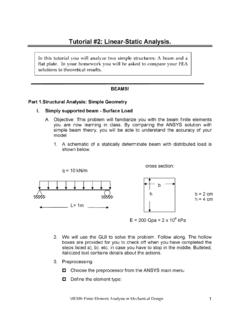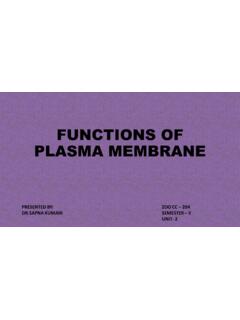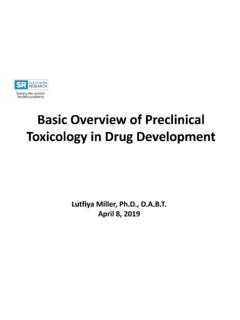Transcription of 1 Introduction to cell biology
1 1 Introduction to cell MotivationWhy is the understanding of cell mechancis important? cells need to move andinteract with their environment cells have components that are highly dependent onmechanics, , structural proteins cells need to reproduce / divide to improvethe control/function of cells to improve cell growth/cell production medical appli-cations mechanical signals regulate cell metabolism treatment of certain diseasesneeds understanding of cell mechanics cells live in a mechanical environment itdetermines the mechanics of organisms that consist of cells directly applicable tosingle cell analysis research to understand how mechanical loading affects cells , cell differentation.
2 Cell morphology to understand how mechanically gated ionchannels work an understanding of the loading in cells could aid in developing struc-tures to grow cells or organization of cells more efficiently can help us to understandmacrostructured behavior better can help us to build machines/sensors similar tocells can help us understand the biology of the cell cell growth is affected by stressand mechanical properties of the substrate the cells are in understanding mechan-ics is important for knowing how cells move and for figuring out how to change cellmotion when building/engineering tissues, the tissue must have the necessary me-chanical properties understand how cells is affected by and affects its environment understand how mechanical factors alter cell behavior (gene expression) how differ-ent cells interact with each other cell behavior may change under different conditions(stress)
3 To be able to study the extend of role of different parts of a cell in its behavior to predict cell behavior or response in different conditions movement/motility ofcell depends on mechanics load bearing, deformation of cells stability/ integrity ofcell is provided by cytoskeleton and influenced by its mechanical properties to un-derstand cells better to manipulate cells as we want to generate something basedon cell s characteristis under physiological change, how does cell mechanics change provide guidance for cell manipulation extract cell properties from experiment observe cell response11 Introduction to cell Introduction to the cellCells are the fundamental building blocks of life. They are the smallest units of anorganism that can be characterized as living.
4 Humans and many other organisms aremulticellular, , they consist of multiple , , or-ganisms consisting of one single cell such as bacteria, algae, and fungi, were the firstform of life on earth about 3-4 billion years ago. Robert Hooke was the first to use theword cell in 1665, however, in the context of non-living cork. Antonie van Leeuwen-hoek was the first person to ever observe a cell under a microscope in 1674. The celltheory biologists use nowadays dates back to major contributions of Schwann andSchleiden in 1839, enhanced by contributios of Virchow in basic elements of theclassical cell theorystate that all living things are composed of cells , cells are the basic unit of structure and function in living things, and cells are produced from other can distinguish between two types of cells ,prokaryotic cells , , cells without anucleus such as bacteria, see figure , andeukaryotic cells , , cells with a distinctnucleus which possess organized chromosomes that store genetic material, see In humans alone, there are more than 200 different cell types of different form andfunction.
5 Some characteristic numbers you might want to remember are the following: humans consists of approximately 100 trillion, , 1014cells, a typical cell size is 10 m smallest cells are less than 1 m in diameter while nerve cells can be up to a 1m long a typical cell mass is 1 is characteristic for all biological cells tobacterialflagellumcapsulecell wallplasma membranecytoplasmpilinucleoidand ribosomesin :Prokaryotic cell. Cell without a nucleus such as Introduction to cell biology reproduce by cell division, metabolize raw materials into energy, and respond to external and internal their functional variety, the basic structural elements of most cells are the same, networks of filaments maintain cell shape and organize its content and fluid sheets enclose the cells and its ribosomerough endo-plastic reticulumsmooth endo-plastic :Eukaryotic animal cell.
6 Cell with a distinct a mechanical point of view, all cells have a remarkably similar layout; they areeven made up of similar subunits. For example, the protein actin, one of the cell s prin-cipal filaments, can be found in almost all cells ranging from yeast cells to human studying the remarkable similarity of the cell s biochemistry and biomechanics, weaim at finding systematics andbasic paradigms that help to explain cellular form andfunction. By characterizing biological cells with the help of the fundamental laws ofphysics, we hope to answer the following questions:How do cells maintain their shape?What are the mechanical properties of the individual components that give the cell it sstrength and elasticity?
7 What are their stability limits?How do cells move?What are the structural components that support cellular motion? How is motion gen-erated according to Newton s laws which teaches us that cells need to adhere to pushthemselves forward?How do cells transport material?What are the mechanisms by which proteins are transported from their production siteto their working site?How do cells interact with their environment?What are the cell s mechanisms to sense environmental changes and respond to them?31 Introduction to cell Introduction to biopolymersA typical finding is that other than most engineering materials like steel or concrete, cells are extremelysoft, almost liquid like. Their mechanical behavior and their mi-crostructure resemble those of rubber.
8 Rubber consists of a network of polymericchains that become more resistant to deformation when heated. This is somewhatcounterintuitive since most engineering materials you might know behave the otherway around. Polymeric materials are characterized byentropyrather thanenergyandwe will see in the next section what that actually means. The first investigations in thecontext of entropy of natural rubber are attributed to Gough 1805. We can distinguishfour main biopolymers carbohydrates lipids proteins, and nucleic are made ofmonomersandpolymers. Monomers are smaller micromoleculessuch as nucleic acids, amino acids, fatty acid, and sugar. Assembled together as repeat-ing subunits, monomers form long macromolecules which are referred to as examples of biopolymers are genes: RNA, DNA gene products: peptide, protein, and biopolymers not coded by genes: lipid, polysaccharide, and of one-dimensional engineering structures such as steel rods.
9 Engineering rodsare usually straight, they don t really change their shape in response to thermal fluc-tuations in their energy. In contrast, biopolymers are very flexible. Upon thermal fluc-tuations, they may bend from side to side and jiggle around. This is the nature of softmatter related to the notion of Introduction to the cytoskeletonThe structural integrity of the cell is maintained by a complex network of tensile andcompressive one-dimensional elements, the cytoskeleton. The cytoskeleton is the cel-lular scaffold which maintains cell shape protects the cell helps to generate cellular motion, and assembles and disassembles dynamically enables intercellular eukaryotic cytoskeleton consists of three main kinds of cytoskeletal filaments41 Introduction to cell biologymicrotubulesattached to centrosomenucleusmembraneactin filamentsclose to.
10 Eukaryotic cytoskeleton, consisting of thin actin filaments and intermediate filaments whichact as tensile ropes and thick hollow microtubules which act as compressive trusses actin filaments or microfilaments, intermediate filaments, 8-12nm in diameter, and microtubules, hollow cylinders, 25nm in diameter with a 15nm filamentsare 7nm in diameter and consist of two intertwined actin chains. Theyare tension bearing members of the cell. Being located close to the cell membrane , theyare responsible for inter- and intracellular transduction. Together with myosin, theyfrom the contraction apparatus to generate muscular contraction of skeletal and car-diac filamentsare 8-12nm in diameter and thus more stable than actin fil-aments.






